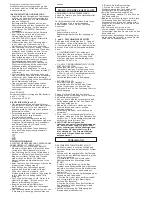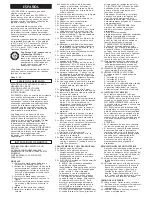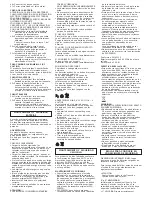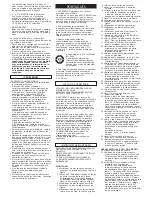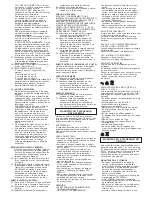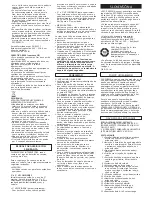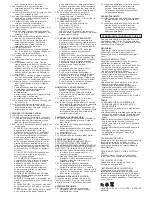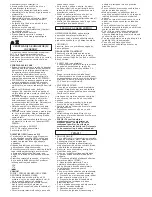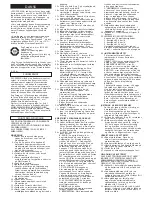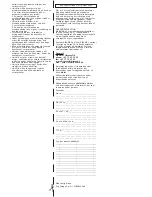
• The barred dustbin indicates that the
product must be subject to sorted waste
collection.
SAFETY
WARNING! THE CAR MUST BE USED UNDER
ADULT SUPERVISION.
• Not suitable for children under the age
of 36 months. The small pieces could
be swallowed or inhaled.maturation to
operate this motorized vehicle safely.
• Never use the vehicle on steep slopes or
near steps or stairs. This vehicle is not
suitable for use on public highways.
• Children should always wear shoes when
riding in or driving a ride-in/ride-on
vehicle.
• Do not allow children to place their hands,
feet or any part of their body, clothing or
other articles near the moving parts while
vehicle is in operation.
• Do not allow the electrical components,
motors, wiring, switches of your
motorized vehicle to become wet and
never wash it with a hose.
• Never use gasoline or other flammable
substances near the vehicle.
• The vehicle has been designed for use by
2 children simultaneously.
RULES FOR SAFE DRIVING
DON'T STOP THE FUN: always have freshly
charged, back-up batteries on hand.
For your child
ʼ
s safety: please read and
follow all instructions below before
operating.
• ATTENTION:
Check the fastening studs to be sure they
are tight.
2nd and 3rd SPEED
We recommend using the 1st speed initially.
Before activating the 2nd and 3rd speed,
make sure that the child is familiar with the
vehicle.
• 1ST SPEED slow speed (beginner drivers):
With both hands on the handlebars, press
down on the accelerator pedal; the vehicle
goes forward at 3,4 Km/h.
• 2ND AND 3RD SPEED (FOR EXPERTS):
With both hands on the steering wheel
press down on the accelerator pedal; the
vehicle goes about 5,4 km/h in 2nd speed
and 11,4 km/h in 3rd speed.
• REVERSE:
Place the other hand on the handlebars on
press your foot down on the accelerator.
The vehicle goes in reverse
Teach your child the proper use of this
vehicle for a safe and fun play time.
• Before starting be sure that the way is free
from people and objects.
• Drive with both hands on the handlebar
and keep your eyes on the road at all
times.
• Stop in time to avoid accidents.
• Activate 2nd and 3rd speed only when
the child knows how to properly use the
steering wheel, 1st speed and brake.
• CAUTION! When operating in overload
conditions, such as soft deep sand, mud
or rough uneven terrain, the overload
circuit breaker will automatically
disconnect the power. After 10 or
more seconds,the circuit breaker will
automatically reset, howevere you must
eliminate overload conditions to resume
normal driving.
PROBLEMS?
IF THE VEHICLE DOES NOT OPERATE?
• Make sure that the battery is hooked up
to the electrical unit.
• If the green LED does not come on
after having properly carried out all the
procedures:
1. Check the circuit board connector
found on the dashboard (START).
2. Charge the batteries. If the problem
persists after recharging, have the battery
and battery charger checked by a service
centre.
• If the vehicle does not move when the
accelerator pedal is pressed remember to:
1. Make sure that the brake pedal is not
activated (the brake lights are on).
2. Check that the accelerator pedal
ʼ
s
steel wire is intact and that it is running
properly.
• If the vehicle does not brake when the
brake pedal is pressed remember to:
1. Regulate the brake pads.
2. Check that the brake pedal
ʼ
s steel wire
is intact and that it is running properly.
• Contact the Service Centre for any
problem related to changing gears.
• The vehicle cannot be used when being
charged with the Jack. If the contrary
occurs, bring the article to a service
centre.
• The vehicle should never go forward by
itself. If the contrary occurs, contact a
service centre.
• If the red LED comes on when the vehicle
is started contact a service centre.
• If it is difficult to move the steering wheel,
we recommend greasing the steering bar
(located underneath the vehicle) and the
wheel joints with grease or light oils
• If the vehicle
ʼ
s light bulbs (head lights and
brake lights) burn out, replace them.
• If the vehicle does not work in spite of all
verifications, contact a service centre.
• PEG PEREGO® vous remercie de votre
confiance et vous félicite d'avoir choisi ce
produit. Depuis plus de 50 ans, PEG PEREGO
emmène en promenade les enfants: à peine
nés, avec ses fameux landaus et poussettes
et plus tard, avec ses fantastiques véhicules
à pédales et à batterie.
• Lire attentivement ce manuel
d'instructions pour se familiariser avec
l'utilisation du modele et enseigner a
l'enfant a conduire prudemment tout en
s'amusant. Garder ce manuel pour toute
necessite future.
• Nos jouets répondent aux conditions
de sécurité prévues, par le Conseil de la
EEC, par le “U.S. Consumer Toy Safety
Specification” et approuvés par le T.Ü.V.
et par le I.I.S.G. Istituto Italiano Sicurezza
Giocattoli.
Peg Perego S.p.A. bénéficie de
la certification ISO 9001.
La certification assure aux clients
et aux consommateurs une
garantie de transparence et de
confiance dans la façon dont
travaille l
ʼ
entreprise.
• Peg Perego pourra apporter à tout
moment des modifications aux modéles
décrits dans cette publication, pour des
raison de nature technique ou commerciale.
Ans 3-10
PEG PEREGO offre un service d
ʼ
assistance
après-vente, directement ou à travers un
réseau de centres d
ʼ
assistance autorisés
pour les éventuelles réparations ou pour
le remplacement et la vente de pièces de
recharge d
ʼ
origine. La liste des centres
d
ʼ
assistance est fournie sur la dernière page
de ce manuel d
ʼ
instructions.
Peg Perego est à la disposition de ses
consommateurs pour satisfaire au mieux
toutes leurs exigences. À cette fin,
connaître l
ʼ
avis de nos clients est pour
nous extrêmement important et précieux.
Nous vous saurions donc gré, après avoir
utilisé l
ʼ
un de nos produits, de bien vouloir
remplir le QUESTIONNAIRE SATISFACTION
DU CONSOMMATEUR
que vous trouverez sur Internet à l
ʼ
adresse
suivante: "www.pegperego.com" et de
nous faire vos éventuelles observations ou
suggestions.
L'ASSEMBLAGE DOIT-ETRE FAIT PAR UN
ADULTE. PRENDRE GARDE DE NE PAS
LAISSER A PROXIMITE DES ENFANTS LES
COMPOSANTS DE PETITES TAILLES OU AUX
BORDS TRANCHANTS.
MONTAGE
1 •
Positionner le para-chocs et fixer les
para-chocs à l
ʼ
aide des 4 vis.
2 •
Enlever les deux ampoules dans le
fond de la partie arrière du véhicule
(près des amortisseurs). Positionner les
ampoules à l
ʼ
intérieur des pare-chocs
arrière, comme indiqué sur la figure.
3 •
Mettre en place le para-chocs arrière.
4 •
Visser le 3 vis comme indiqué dans la
figure.
5 •
Poser la trousse à outils sur le capot et
la fixer comme dans le dessin.
6 •
Assembler les deux parties du volant.
7 •
Monter le volant sur son axe.
8 •
Alligner les trous de l
ʼ
axe du volant et
du volant. Serrer la vis et lécrou comme
dans la figure, fixer l
ʼ
écrou dans le
trou hexagonal et la vis dans le trou
circulaire.
9 •
Insérer le pare-brise comme dans la
figure.
10 • Fixer le pare-brise par les 2 vis en
dotation.
FRANÇAIS
SERVICE D
ʼ
ASSISTANCE
INSTRUCTIONS DE MONTAGE

















